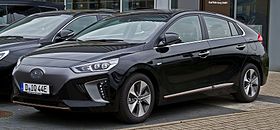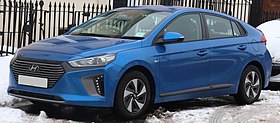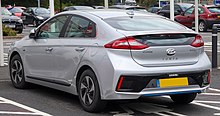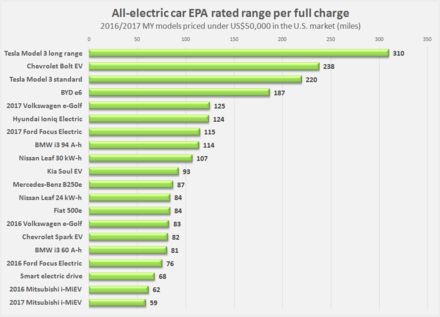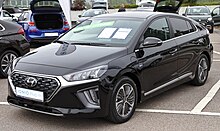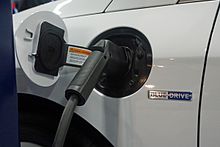
A hybrid vehicle is one that uses two or more distinct types of power, such as submarines that use diesel when surfaced and batteries when submerged. Other means to store energy include pressurized fluid in hydraulic hybrids.
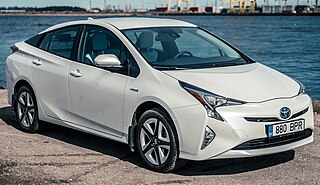
The Toyota Prius is a compact/small family liftback produced by Toyota. The Prius has a hybrid drivetrain, combined with an internal combustion engine and an electric motor. Initially offered as a four-door sedan, it has been produced only as a five-door liftback since 2003.

The Honda Insight is a hybrid electric vehicle that is manufactured and marketed by Honda. Its first generation was a two-door, two passenger liftback (1999–2006) and in its second generation was a four-door, five passenger liftback (2009–2014). In its third generation, it became a four-door sedan (2018–2022). It was Honda's first model with Integrated Motor Assist system and the most fuel efficient gasoline-powered car available in the U.S. without plug-in capability — for the length of its production run.

The Toyota RAV4 EV is an all-electric version of the popular RAV4 SUV produced by Toyota until 2014. Two generations of the EV model were sold in California, and to fleets elsewhere in the US, with a gap of almost ten years between them.

The Ford Fusion Hybrid is a gasoline-electric hybrid powered version of the mid-sized Ford Fusion sedan manufactured and marketed by Ford, now in its second generation. A plug-in hybrid version, the Ford Fusion Energi, was released in the U.S. in February 2013.

The Ford C-Max is a car produced by the Ford Motor Company from 2003 to 2019. It has a five-door compact multi-purpose vehicle (MPV) design. The Ford Grand C-Max has a longer wheelbase.
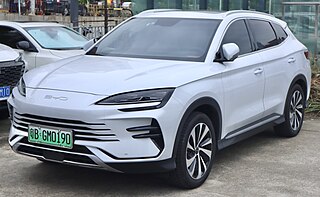
A plug-in hybrid electric vehicle (PHEV) is a type of hybrid electric vehicle equipped with a rechargeable battery pack that can be replenished by connecting a charging cable into an external electric power source, in addition to internally by its on-board internal combustion engine-powered generator. While PHEVs are predominantly passenger cars, there are also plug-in hybrid variants of sports cars, commercial vehicles, vans, utility trucks, buses, trains, motorcycles, mopeds, military vehicles and boats.

The history of plug-in hybrid electric vehicles (PHEVs) spans a little more than a century, but most of the significant commercial developments have taken place after 2002. The revival of interest in this automotive technology together with all-electric cars is due to advances in battery and power management technologies, and concerns about increasingly volatile oil prices and supply disruption, and also the need to reduce greenhouse gas emissions. Between 2003 and 2010 most PHEVs on the roads were conversions of production hybrid electric vehicles, and the most prominent PHEVs were aftermarket conversions of 2004 or later Toyota Prius, which have had plug-in charging and more lead-acid batteries added and their electric-only range extended.

Miles per gallon gasoline equivalent is a measure of the average distance traveled per unit of energy consumed. MPGe is used by the United States Environmental Protection Agency (EPA) to compare energy consumption of alternative fuel vehicles, plug-in electric vehicles and other advanced technology vehicles with the energy consumption of conventional internal combustion vehicles rated in miles per U.S. gallon.

The BMW i8 is a plug-in hybrid sports car developed by BMW. The i8 was part of BMW's electrified fleet and was marketed under the BMW i sub-brand. The production version of the BMW i8 was unveiled at the 2013 Frankfurt Motor Show and was released in Germany in June 2014. Deliveries to retail customers in the U.S. began in August 2014. A roadster variant was launched in May 2018. Production ended in June 2020.

The adoption of plug-in electric vehicles in the United States is supported by the American federal government, and several states and local governments.

The Toyota Prius Plug-in Hybrid is a plug-in hybrid liftback manufactured by Toyota. The first-generation model was produced from 2012 to 2016. The second-generation model has been produced since 2016. Production of the third-generation model began in 2023.
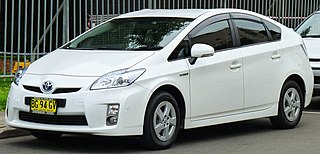
The third generation Toyota Prius debuted as a compact liftback manufactured and marketed by Toyota, having launched in 2009 for model year 2010 at the January 2009 North American International Auto Show. Internally designated as model XW30 and replacing the XW20 series, sales began in Japan on May 18, 2009.

The Toyota Prius (XW10) is a subcompact hybrid car that was produced by Toyota between 1997 and 2003 in Japan. The XW10 is divided into the NHW10 and its NHW11 counterpart, both of which represent the first generation of Prius series. The Toyota Prius is the first mass-produced hybrid car, and was released 2 years ahead of other manufacturers. While the NHW10 was available exclusively to Japan, it was subsequently introduced to worldwide markets in September 2000 with the NHW11. Toyota sold about 123,000 first generation Prius. Toyota's XW10 series Prius is notable as the first vehicle based on the Toyota MC platform.
The following table compares official EPA ratings for fuel economy for series production all-electric passenger vehicles rated by the EPA for model years 2015, 2016, 2017, and 2023 versus the model year 2016 vehicles that were rated the most efficient by the EPA with plug-in hybrid drivetrains, gasoline-electric hybrid drivetrains, and the average new vehicle for that model year, which has a fuel economy of 25 mpg‑US.
The following table compares EPA's estimated out-of-pocket fuel costs and fuel economy ratings of serial production plug-in hybrid electric vehicles rated by EPA as of January 2017 expressed in miles per gallon gasoline equivalent (mpg-e), versus the most fuel efficient gasoline-electric hybrid car, the 2016 Toyota Prius Eco, rated 56 mpg‑US, and EPA's average new 2016 vehicle, which has a fuel economy of 25 mpg‑US. The table also shows the fuel efficiency for plug-in hybrids in all-electric mode expressed as KWh/100 mile, the metric used by EPA to rate electric cars before November 2010.

The Kia Niro is a compact crossover SUV (C-segment) manufactured by Kia since 2016. It is an electrification-focused vehicle, offering three versions: hybrid, plug-in hybrid and battery electric variants.

The fourth-generation Toyota Prius is a compact car that was manufactured by Japanese automaker Toyota from 2015 to 2022. It was first shown during September 2015 in Las Vegas, and was released for retail customers in Japan on 9 December 2015. The launch in North American market occurred in January 2016, and February in Europe and the Middle East. Toyota expected to sell 12,000 fourth generation Prius cars a month in Japan, and to reach annual sales between 300,000 and 350,000 units.

The ninth generation Accord is a mid-size car introduced by Honda in 2012 which received a refreshed front fascia, grille, headlights, tail lights and alloy wheel designs for the 2016 model year. With the discontinuation of the smaller European and Japanese market Accord in 2015, the larger North American Accord became the only version in production, with the Hybrid version taking over as the flagship of Honda's automotive product in many markets that once received the smaller Accord.

The Hyundai Ioniq 5 is a battery electric compact crossover SUV produced by Hyundai since 2021. It is the first product to be marketed under the electric cars-focused Ioniq sub-brand, and the first model developed on the Hyundai Electric Global Modular Platform (E-GMP).
